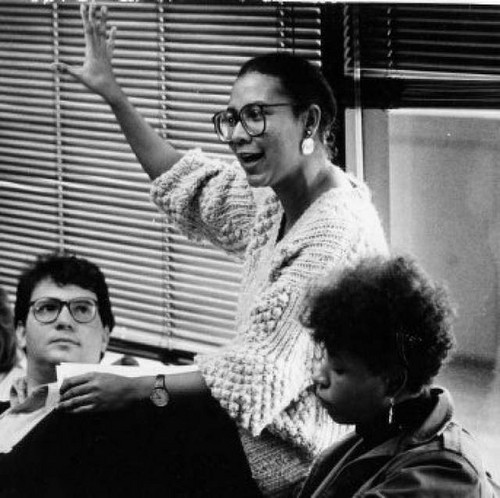A friend of mine recently challenged me to read the book Feminism Is For Everybody by Bell Hooks. He told me that, as a gender studies major, he found the pop culture version of feminism to be very different from the academic feminism he was studying, and said that if I wanted to talk about feminism, I needed to read major feminist writing.
Since I actually enjoy listening to friends and authors I disagree with, I told him I’d read the book with an open mind. While Feminism Is For Everybody didn’t make me a feminist, it did show what’s wrong with feminism, and how to fix it.

What Does the Book Say?
In the introduction, Bell Hooks states this book is specifically intended to convince men, who “have no idea what it is feminists want” and are only familiar with feminism through “patriarchal mass media” that “they would find in feminist movement the hope of their own release from the bondage of patriarchy.” In other words, if you read ROK, you’re her target audience.
Hooks defines feminism as “A movement to end sexism, sexist exploitation, and oppression” and considers patriarchy synonymous with domination. By defining patriarchy as a system of domination, rather than a division of social roles intended for mutual benefit, Hooks creates a straw man that equates patriarchy with oppression.
Her writing often delves into broad generalizations without any examples or definitions. For example:
Males as a group have and do benefit the most from patriarchy, from the assumption that they are superior to females and should rule over us. But those benefits have come with a price. In return for all the goodies men receive from patriarchy, they are required to dominate women, to exploit and oppress us, using violence if they must to keep patriarchy intact.
Hooks doesn’t define what “ruling over women” means, what “goodies men receive,” how men dominate women, or give any examples of actual violence committed to “keep patriarchy intact.” Her description is so vague, there’s no way to verify or falsify any of the claims she’s made. She gives no facts of any kind and only a handful of anecdotes, making the majority of the book simply opinions she asserts without evidence.

Where Bell Hooks becomes interesting is her critique of the feminist movement.
Are Feminists Anti-Male?
In her history of feminism, Hooks acknowledges “There was indeed a great deal of anti-male sentiment among early feminist activists,” since many came to the movement from physically abusive marriages. Despite this, Hooks argues that modern feminism is not anti-male, and the problem was that “conservative mass media constantly represented feminist women as man-haters.”
However, when talking about “anti-sexist men” joining the movement, she states:
Anti-male factions within the feminist movement resented the presence of anti-sexist men because their presence served to counter any insistence that all men are oppressors, or that all men hate women… They portrayed all men as the enemy in order to represent all women as victims.
Hooks’s writing is full of contradictions. She says in the opening that men benefit from patriarchy, and then later states “men who are not rich and powerful” don’t have much privilege and are discovering that patriarchy doesn’t benefit them. Which is it?
Her aspirations for feminism frequently contradict the things feminists actually say and do:
When feminist movement was “hot,” radical lesbian activists constantly demanded that straight women reconsider their bonds with men, raising the question of whether or not it was possible for women to ever have a liberated heterosexual experience within a patriarchal context…
Teaching one of my first women’s studies courses in San Francisco I was confronted by a group of radical lesbian students who wanted to know why I was still “into” men. After class one day in the parking lot there was a showdown.
If a group of straight men had a “showdown” in the parking lot with their gay professor, asking him why he was still into men, we would call them homophobic. While Hooks tries to fight the image of feminists as angry lesbians, her few personal anecdotes illustrate a significant portion of the feminist movement is deeply heterophobic.

Are Women The Primary Abusers?
“In a zealous effort to call attention to male violence against women reformist feminist thinkers still choose often to portray females as always and only victims. The fact that many violent attacks on children are perpetrated by women is not equally highlighted.”
One area I found myself agreeing with Hooks was her condemnation of child abuse perpetrated by women. Hooks’s willingness to confront female violence is incredibly brave, even if she frames it with the absurd statement that this abuse only comes from the fact many women are “more patriarchal” than men.
Women are often the primary culprits in everyday violence against children… Maternal sadism often leads coercion of children must be seen as just as horrendous as male abuse… A serious gap in feminist thinking and practice has been the refusal of the movement to confront head-on adult female violence against children.
Hooks states that the root of male violence is abuse, and shame received at the hands of the mother, because “abusive shaming lays the foundation for other forms of abuse.” As she illustrates in the best passage of the book:
Often I tell the story of being at a fancy dinner party where a woman is describing the way she disciplines her young son by pinching him hard, clamping down on his little flesh for as long as it takes to control him. And how everyone applauded her willingness to be a disciplinarian. I shared the awareness that her behavior was abusive, that she was potentially planting the seeds for this male child to grow up and be abusive to women. Significantly, I told the audience of listeners that if we had heard a man telling us how he just clamps down on a woman’s flesh, pinching her hard to control her behavior it would have been immediately acknowledged as abusive. Yet when a child is being hurt this form of negative domination is condoned. This is not an isolated incident – much more severe violence against children is enacted daily by mothers and fathers.
If women are the primary perpetrators of child abuse, and pass these patterns of abuse on to their children, the system of oppression Hooks opposes is actually matriarchal. It is a system perpetrated and passed down through bad mothers. Hooks calls her own mother “the strongest patriarchal voice in my life,” and frequently hints at an incredibly unhappy and abusive childhood.

Is Family the Solution?
Since the need to dominate others originates from feelings of powerlessness in childhood, then the solution would be to make sure children are loved and accepted. What has feminism done to make sure boys grow up in happy homes?
Hooks herself says, “No significant body of feminist literature has appeared that addresses boys.” Due to the influence of feminism, boys are frequently shamed simply for being masculine, drugged at young ages for wanting to play, and are falling behind women in school and work.
While Hooks advocates men playing an equal role in child rearing, most boys are now being raised in single-parent, or divorced homes, with most divorces initiated by women. Feminist policies have resulted in less involvement from fathers, and total matriarchal control of the household.
Hooks seems uncomfortable with the idea of motherhood, saying “Female sexual freedom requires dependable, safe birth control… It evokes fear within me just to imagine a world where every time a female is sexual she risks being impregnated.” She criticizes authors who suggest women can find happiness in making raising children their primary role. She projects oppression onto men, even defining her own mother’s abuse as masculine, so she can avoid truly confronting it, and continue to play out the pattern of powerlessness she learned as a child.
If women want a world without violence, they can raise one. Making sure children are loved and accepted would mean embracing the role of motherhood. It would mean taking the needs and feelings of boys seriously. It would mean choosing male partners interested in fatherhood, and giving them the support they need to remain in their children’s lives. It would mean making the family, and the needs of children the most important organizing principle of society. If that sounds like patriarchy, then maybe patriarchy is for everybody.
Read More: Why We Need To Fight For The Patriarchy
Good article. That’s a principle Arnie followed, super-setting chest and back. E.g. http://www.bodybuilding.com/fun/arnold-a-to-z-superset-man.html
Brilliant
I’m sorry but if you are going low enough on your squats, you will be doing a great hamstring workout.. what’s all this about needing to balance squats with deadlifts?
No need to apologize.
The hams extend the hips, and flex the knees. Deep squats only train the first. Of course, so do deads, but the sample program do include leg curls.
Good stuff.
About three weeks ago I started doing this type of workout and it’s already made a huge difference.
I do a fullbody workout, 3x per week, just 1-2 sets per body part but hitting it REALLY hard and giving everything you got during that set or two. I went to high school with the guy who started this fitness company (http://www.fatburningfurnace.com) and it seems to work, especially if you are a busy slave, er professional, given its about 30 min per workout.
I personally found Beyond Brawn to be much more informative in the area of training programmes – Starting Strength is more of a technique guide.
Abbreviated, heavy training is the way forward – you only really need to lift 3 out of 7, or 4 out of every 9 days (depending on how you split your exercises), for 45 minutes at a time to see great results. No cardio required either.
Particularly for older ( 35+ ), regular guys, BB ought to be required reading. Many, if not most, guys in their 20s, particularly the demographic who tend to gravitate to weight training, probably can benefit from being a little bit less cautious that McRobert advices.
Another thing that should be mentioned, is that heavy leg work helps grow the posing muscles (chest, biceps…) as well. Many of the responses and adaptions the body goes through to make itself better able to withstand the kind of heavy loads used in squats and deads, are systemic; and simply cannot be obtained by curling and benching.
Legs I believe are the most crucial part people skip however my biggest problem is doing squats. Is there an easy starting point for them? you basically jack up your whole body really quick if you don’t know what you’re doing.
Tons of resources out there but the best move is always find a dude who knows what he’s doing to walk you through it in person. It’s awkward to ask someone at the gym, but in my experience bodybuilders are like gun enthusiasts. Many people are scared of them, but they all turn out to be evangelists for their hobby and really like helping people get into it.
And then practice with just the bar, and don’t give a fuck who’s looking. And continue to not give a fuck who’s looking because ass to the grass squats are gonna require a lighter weight than parallels and quarter squats and whatever else you see Weekend Schwarzenegger doing with bar-bending quantities of plates.
And remember, Madeline Albright lifted 900 pounds on the leg press. This tells you: leg press is bullshit.
I don’t know where you get that on leg presses. Not all Leg Presses are equal, so they are certainly not a reliable indicator. Hugh Jackman leg pressed around 1000 lb, I would be more inclined to go by that. As for 5×5, I have found it a really good way of improving strength, it does improve definition, and if significant size is what you want it does that too. The thing with 5×5, is that allows you to constantly improve, whether that be 1 rep per week, 5-7lb ( 2.5-5kg) per month or month and a half, or a rep or two each set. It allows you to scale back or deload when necessary, overall it allows you to take control of your own training. When training deadlifts it is recommended to do a heavy session every 10-14 days, if you are natural. Hyperextensions really help keep the lower back strong when doing this exercise, so I always do a sets regularly.
Practicing with just the bar is good, but I would suggest a normal sized male add a 25lb plate on each side rather quickly, as only the bar leaves the center of gravity of the whole upper-body+bar complex too far down the spine. Resulting in a technique that doesn’t transfer too well into using heavier weights. Once you get to a 95lb bar, most of the COG change from dry to a bar with lots of weight has already taken place.
Then do 95s until technique is decent, work up to a 45 on each side, and then pause to polish technique further.
Taking a bit of pause on each 25 and 45 added, is probably a good idea, since the heavier you go, the graver the result of a technique mishap.
And, go as deep as you can. Ass-to-grass as the football coaches say. If you for some reason squat until you’re resting on ligaments, or sitting on your heels, make sure to have spotters or spotter pins well positioned, since getting really strong until X degree angle, and completely untrained at X+1, is a recipe for a disaster should you fail a rep.
To clarify, I’m not one of these self-validating types who wanders the gym, offering my “good advice” to people working out. Man, those types are annoying. I’m not a personal trainer, either. I’m nothing special, really; just have been quietly going to various gyms and lifting weights for 12 years (I’m 37).
I do, however, overhear a lot of people who say they’re apprehensive about incorporating squats into their routines because they’re afraid of hurting their backs or, more frequently, their knees. So I want to help, because I can remember being a beginner. Remember: Lifting your max, or close to it, is not what’s most important. In my opinion, two of the most important factors in weightlifting, to get the results you want, are: 1) Correct form 2) Regularly scheduled workouts.
I can agree with what JC Deen said (and he is obviously a professional, whereas I am not): find a weight that you can do 5 sets of 5 squats with. In my experience, 5 sets of 5 has been a very good squat strength builder. In fact, 3-5 sets of 3-5 reps seems to be a good strength builder for most any exercise.
Got a TV? I used to stand facing the TV and practice doing bodyweight-only squats. I did this a lot, as many as I could do, and while doing so I worked on nailing down the correct form.
Box squats are another good way to work on your squat form, to develop a good, deep squat that will work all the muscles effectively. Search Youtube for “Westside Barbell box squats” for a good explanation of the technique. Hopefully, your gym will have a squat box somewhere near the squat cages.
I know, because you guys are smart (you wouldn’t be visiting this website, otherwise), you already know squats do not only work the legs. So I guess the question would be: what’s the best way to strengthen one’s back muscles, gluteus muscles, and abdominals to improve one’s squat overall?
In my experience, if the gym you go to has a machine called a “glute-ham developer” (gluteus-hamstring), use that and use it often. Glute-ham raises are one of the best bodyweight exercises I can think of for working the lower back and hamstrings. Regular sets of glute-ham raises can also be good for preventing hamstring injuries, if you play a lot of sports. Try doing 3 sets of 6-8 glute-ham raises to start. If you’re already an experienced weightlifter, try 3 sets of 15-20. Of course you can do them holding a plate-weight against your chest for more of a challenge.
Kettlebell exercises (although it’s the “trendy” exercise at the moment and may seem distasteful for that reason) such as 1- and 2-arm swing and snatch are very good for hamstrings, gluteus and lower back. Shoulders and forearms, too, if you’re trying to improve your bench press. But I would recommend finding a really good kettlebell trainer, as opposed to wasting any ca$h on someone’s expensive, hyped up DVD or expensive, mostly-filler book. But because the fake kettlebell trainers vastly outnumber the good kettlebell trainers these days, I’d say just stick with the free weights, unless the trainer comes very highly recommended.
Exercises for the abdominals, to help improve one’s squat: aside from the obvious leg lifts and modified crunches of various types, you can actually get a pretty good abdominal workout doing pull-ups, chin-ups, and parallel bar dips. Being able to do a lot of push ups, I think, is good for the abdominals and good for overall strength. Of course, Roman chain leg lifts are always good for abs; wearing a pair of steel-toed boots. I haven’t done a sit-up in years.
Like the guy who commented above (“Jamed”) I don’t do deadlifts. They seem to be superfluous addition to my workout, and besides, I’m not a powerlifter or other sports competitor.
BTW, many thanks to Roosh for his great website(s). Roosh is a fine writer, and it seems with this site he’s building a coterie of other fine writers, whose perspectives I also enjoy. I’m a regular visitor, first time poster. Thanks
See Rip: squat tutorial. Also consider buying his book Starting Strength, which is excellent. Wish I found it years ago.
Friends don’t let friends skip leg day. This is great I gotta work on my back some more, focusing on db rows etc to fill out my back, at first I was way to enthusiastic with shoulders and chest.
I’m an amateur, but here are a few pieces of friendly advice:
1.) Learn good form to avoid injury. An injury at any age will set you back father than anything else.
2.) Learn good nutrition. Diet is as much or more important than exercise. Learn to fuel your body. Calculate how many calories you need for maintenance. Learn how to reduce calories without losing muscle mass. Learn how to increase calories without adding too much fat. This is part science and art.
3.) Be sore. No pain, no gain. Nuff said.
4.) Train cardio. Added cardiovascular capacity will allow you to lift weights with higher intensity.
5.) Get enough rest. Sleep and recovery time are important. Do not neglect them. I cannot overstate this.
6.) Mix things up. The body is excellent at adaptation. Keep it guessing. Also, this is good for avoiding boredom and burnout. Tired of running? Try swimming. Hit a plateau when lifting? Work on your run times. Tired of pumping iron, do crossfit/bodyweight.
7.) Don’t sweat the occasional cheat meal, drinking night, or missed workout. Allow yourself lapses in discipline. You’re in for the long haul. Depending on your workout frequency, you may be working out 100 – 200 times per year. (Even one workout per week is better than the average American.) If you miss one, no sweat. If you pig out at a birthday or drink at a friend’s wedding. It’s just one day. You will not destroy all your gains overnight. Slow and steady.
8.) Compete against yourself. Unless you’re competing, it’s not a contest. Work on yourself. Look at guys ahead of you as where you want to go, and look at guys behind you as evidence of where you were. Always encourage those guys just starting out.
9.) Extraordinary results require extraordinary measures. You won’t get a six-pack if you fool around in the gym and don’t dial in your diet.
10.) If it jiggles, it’s fat.
so many contrary opinions on muscle building and from men who are ALL qualified- confusion reigns. you must stop reading all articles/books about training, and just lift on your own. go in with the spirit of experimentation and find your own path, certainly some expert somewhere has written up the perfect routine/diet for you, but why bother wasting time sifting through mountains of info trying to find it.
just put down your books, close your computer and lift right now, and never read anything about strength/bodybuilding ever again- when the urge to read hits you, pick up a barbell and start lifting- you will be miles ahead of the keyboard trainers.
As mentioned by another commenter, only someone with no knowledge of human anatomy would suggest you have to “balance” squats with anything. The properly-performed squat is a full-body exercise (due to isometric contraction of stabilizer muscles) which fully recruits the posterior chain. When descending on the squat, the hamstrings are fully recruited through their entire range of motion. When extending on the squat, proper form involves recruitment primarily of the gluteus maximus, not the quadriceps. The quadriceps serve to stabilize the knee joint, which is their natural function anyway. Yes, the quads also flex the knee joint. How much strength do you need to lift your foot off the ground and bend your knee? Answer: Not much. This is not the primary purpose of the quads.
It is simply ignorant to suggest that because the hamstrings both flex the hip and flex the knee, it is necessary to do two exercises. The hamstring connects the hip to the knee. It’s the same freaking muscle group. If you’re exercising it through the full range of motion, you are exercising the whole thing. This is just simple physics, people. There’s no exercise which targets just one “end”.
I can’t explain how someone can include a recommendation for Starting Strength in the same article as they suggest that squats don’t exercise the posterior chain. Starting Strength is a great guide, but it doesn’t seem Mr. Deen has bothered to read it.
Lol, forget all that. Learn the snatch and clean and jerk.
http://www.youtube.com/watch?v=VCuh8trNago
ok what does the 5 x 5 and 4 x 8 mean ….and are Reps? the number of times done
im literally rotting away by the definition of the word and need to gain muscle i want to do the stuff listed above or at least 3 of them my legs are naturally strong and are my pride of power but all else Arms,back upper body im decaying like a zombie and losing weight for no reason i need info quick and the internet does not give answers anymore they only give questions for questions
So this is legs. I like this combo. Do you have biceps/shoulder workouts? SOmething that includes squats and such?
Squats 5×5 (25 reps)Hyperextension 5z5 (25 reps)
DB Lunges 4×8 (32 reps)
Leg curls 4×8 (32 reps)